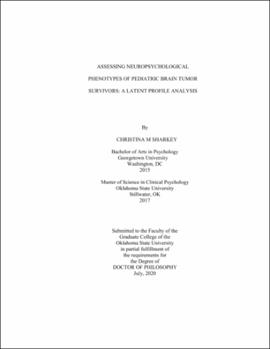| dc.contributor.advisor | Mullins, Larry L. | |
| dc.contributor.author | Sharkey, Christina M. | |
| dc.date.accessioned | 2021-02-22T22:24:18Z | |
| dc.date.available | 2021-02-22T22:24:18Z | |
| dc.date.issued | 2020-07 | |
| dc.identifier.uri | https://hdl.handle.net/11244/328629 | |
| dc.description.abstract | Introduction: Survivors of pediatric brain tumors are at significant risk for both neurocognitive impairments and psychological adjustment difficulties. However, these domains of negative sequelae are primarily examined as distinct sets of symptoms. Thus, the current study aimed to evaluate comprehensive profiles of late effects, across both neurocognitive and psychosocial domains, experienced by young brain tumor survivors. Additionally, several demographic and disease characteristics were evaluated as predictors of late effect profiles. | |
| dc.description.abstract | Method: Pediatric brain tumor survivors (N=89) who were assessed in a neuropsychological clinic between May 2009 and May 2018, were diagnosed at least one year prior, and were off-treatment for at least three months, were included. Parent- and teacher-report of psychological symptoms (Child Behavior Checklist and Teacher Report Form), and performance-based measures of neurocognitive functioning (Wechsler Scales, Tower of London-DX-Drexel Version) were examined using latent profile analysis and model fit criterion including the bootstrapped likelihood ratio difference test and the Bayesian Information Criteria. The R3STEP procedure was employed to identify predictors of class membership. | |
| dc.description.abstract | Results: Four classes were identified: (1) "Average" (n = 47) characterized by average functioning across all domains, (2) "Cognitive Deficit" (n = 25) characterized by average psychosocial functioning and impaired cognitive functioning, (3) "Social/Cognitive Deficit" (n = 9) characterized by elevated social problems and significant neurocognitive impairments, and (4) "Discrepant" (n = 8), characterized by impaired visual planning and problem-solving and elevated parent-reported psychosocial problems, but average processing speed, working memory, and teacher-reported psychosocial outcomes. Ethnicity, race, treatment with radiation, and the diagnoses of neurofibromatosis 1, hydrocephalus, and posterior fossa syndrome, were all significant predictors of class membership (ps < 0.05). | |
| dc.description.abstract | Conclusion: Findings were consistent with extant literature, while also shedding light on patterns of relations among neurocognitive and psychosocial domains among survivors. Results show that distinct neuropsychological phenotypes may exist, suggesting the need for closer examination of demographic and illness-related factors that appear to contribute to neuropsychological profiles. | |
| dc.format | application/pdf | |
| dc.language | en_US | |
| dc.rights | Copyright is held by the author who has granted the Oklahoma State University Library the non-exclusive right to share this material in its institutional repository. Contact Digital Library Services at lib-dls@okstate.edu or 405-744-9161 for the permission policy on the use, reproduction or distribution of this material. | |
| dc.title | Assessing neuropsychological phenotypes of pediatric brain tumor survivors: A latent profile analysis | |
| dc.contributor.committeeMember | Chaney, John | |
| dc.contributor.committeeMember | Hawkins, Misty | |
| dc.contributor.committeeMember | Koch, Julie | |
| osu.filename | Sharkey_okstate_0664D_16628.pdf | |
| osu.accesstype | Open Access | |
| dc.type.genre | Dissertation | |
| dc.type.material | Text | |
| dc.subject.keywords | brain tumor | |
| dc.subject.keywords | neurocognitive | |
| dc.subject.keywords | pediatric | |
| dc.subject.keywords | psychosocial | |
| thesis.degree.discipline | Psychology | |
| thesis.degree.grantor | Oklahoma State University | |
